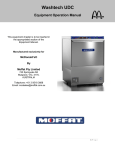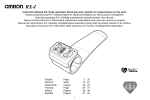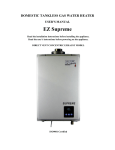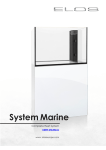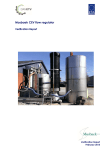Download Specification Sheet - Catering Equipment Supplier
Transcript
-1- INSTRUCTION MANUAL INDUSTRIAL DISHWASHER EN INSTRUCTION MANUAL – FOR INSTALLER - ENGLISH INDUSTRIAL GLASS AND DISHWASHER, UNDERCOUNTER FOR EXCLUSIVE USE OF TECHNICALLY QUALIFIED PERSONNEL Attention: READ THESE INSTRUCTIONS CAREFULLY BEFORE PROCEEDING WITH THE INSTALLATION AND OPERATION OF THE MACHINE. ANY INSTALLATION, ALTERATION, OR MODIFICATION THAT DOES NOT MEET THE STANDARDS IN THIS MANUAL MAY CAUSE A MALFUNCTION OR DAMAGE TO THE MACHINE. THE WARRANTY WILL NOT BE CONSIDERED VALID AND THE COMPANY WILL NOT BE LIABLE IN THE EVENT OF INCORRECT USE, OR FOR ANY DAMAGE CAUSED BY NEGLIGENCE OR FAILURE TO FOLLOW THESE INSTRUCTIONS. 1.1 Installation: The Installation must be performed only by authorised personnel and in compliance with the laws in force and these instructions. 1.2 Modifications: The manufacturer reserves the right to modify the equipment or the content of instructions, without prior notice. 1.3 Defects and malfunctions: In the event of a defect or malfunction, the main electricity supply and water supply MUST be isolated not only in the machine but also at the wall. 1.4 Repairs and Spare Parts: The product should be serviced only by authorised personnel, with the use of original spare parts. DECLARATION OF CONFORMITY EUROPEAN DIRECTIVE 2002/95/CE RoHS SUMMARY General information, water supply Installation and start up Electrical connection Control panel Commissioning Adjusting the dosing Troubleshooting Page 02 Page 03 Page 05 Page 06 Page 08 Page 09 Page 12 -2- EN INSTRUCTION MANUAL INDUSTRIAL DISHWASHER GENERAL INFORMATION This dishwasher is in compliance with the provisions currently in force concerning safety. Improper use can cause damage to people and / or property. Before starting the machine, read these instructions containing important information about installation and safety. This manual is an integral part of the dishwasher and must be kept intact. The dishwasher is only intended for professional use. It is designed for washing utensils (cups, plates, cups, bowls, trays, cutlery) and in similar areas in the field of food and catering, and complies with international electrical and mechanical safety and EMC. Personnel operating the machine must be regularly trained. Only trained personnel should use it. The dishwasher is not suitable for use by minors and persons with reduced physical or sensory abilities, nor by people with psychological problems. The use of the machine is permitted only to persons under the supervision of a responsible person. Do not allow children to play with the dishwasher, there is the danger that they may become locked inside. The manufacturer disclaims any liability for damage to persons or property caused by disregarding these instructions in the booklet, or by incorrect use, and by interference with any part of the dishwasher. Replace any defective parts with new original parts. This is the only way that the manufacturer guarantees the observance of safety standards and the correct operation of the machi- ne. Do not use the dishwasher as a ladder, or to support people, objects or animals. Leaning or sitting on the open door could cause it to tip over and endanger people. Close the door to prevent people tripping over it. Before installing this appliance, check that no damage is visible. Never operate a damaged machine—it can be very dangerous. The dishwasher must be installed and repaired only by authorised personnel. Work performed incorrectly can cause serious hazards to the user, for which the manufacturer is not responsible. The electrical safety of the machine is ensured only by a correct earth connection. It is very important to make sure that this connection has been done correctly. If in doubt, have the system checked by a qualified technician. The manufacturer is not lia- ble for any damages due to the absence of, or incorrect installation. Observe the installation instructions contained in the installation manual. Prior to an electrical connection it is necessary to compare the technical data, voltage and frequency shown on the machine nameplate, with the mains supply. The electrical supply must match the machine demands, otherwise the machine could be damaged. If in doubt, have the system checked by a qualified electrician. Do not connect the machine to the mains with extensions because there is insufficient electrical security. To perform the installation work, or any maintenance or repair, disconnect the machine from the mains. The machine is connec- ted to the mains unless the isolating switch is off. Be careful when handling chemical products! These products, such as detergent and rinse aid, can be corrosive or irritant. Follow the safety regulations on the packaging! Wear goggles and gloves! Carefully follow the safety instructions provided by manufacturers. Do not inhale powder detergent. Ingesting detergent can cause burns to the mouth and throat and lead to suffocation. After any work done to the water supply, you must purge the water pipes to the dishwasher, or you risk damaging the water inlet valve. The machine and the surrounding area should not be sprayed directly with a jet of water. Do not open the door when the machine is operating. There is a DANGER of splashing with hot water and detergent. If you open the door at the end of the programme take care not to touch the heating elements located on the bottom of the tank (dan ger of burns). -3- EN INSTRUCTION MANUAL INDUSTRIAL DISHWASHER INSTALLATION AND START UP The installation of the machine must be carried out only by qualified technical personnel, in accordance with these instructions and in compliance with the regulations. ¨ Remove the packing and the polystyrene from the machine, and check for damage. If damaged they must be notified in writing to the carrier. The packaging components (plastic bags, polystyrene foam, nails, etc.) must be kept away from children and pets, as potential sources of danger. All materials used for packaging are compatible with the environment. They can be stored safely, or be disposed of at an appropriate waste disposal center. The components of wood and cardboard can be disposed of in accordance with regulations. When disposing of the machine, to avoid dispersion in the environment; dismantling must be in compliance with current standards at the time. ¨ Check that the location of the installation allows for easy maintenance. In particular, check that there is no moisture, that there are no heat sources in the vicinity and that there is an adequate exchange of air. ATTENTION The installation of the machine must comply with national and local regulations and by-laws. ¨ The manufacturer disclaims any liability for any direct or indirect damage to persons or property resulting from the violation of such laws. ¨ Before selecting the installation site, check the surrounding area for objects that could be damaged by water vapor or splashes of washing solution, from the proximity of the machine. ¨ Open the door and remove the following equipment: dishwashing basket, cutlery basket, tube for inlet and outlet, rubber feet, user manual and installation manual with a wiring diagram and certificate of conformity. ¨ Remove the four rubber feet and screw in the threaded holes in the bottom of the machine. The dishwasher must be stable and level (use a level). Any irregularities in the floor can be compensated using the four adjustable feet. ¨ Connect the inlet hose, supplied to the appropriate solenoid valve nipple. Make sure you include the gasket seal. ¨ Attach the end of the water hose to the faucet with a 3/4" BSP male fitting. The valve must be installed in an easily accessible location. Make sure that after installing the pipe is not crimped or crushed. -4- INSTRUCTION MANUAL INDUSTRIAL DISHWASHER EN ATTENTION! The dishwasher can be connected to the cold water system (minimum temperature + 5 ° C) or to the hot water system (maximum temperature +50 ° C) with appropriate loading pipe to the standard EN 61770. For connection to the water mains use only new hoses. Old or used hoses must not be used. The results from the machine will always be best, if the incoming water supply to the machine uses pure water. Water that contains hardness (calcium and magnesium, 150ppm or above) will lead to limescale deposits in the rinse jets, re- stricting the water flow during rinsing and filling. This leads to poor results, detergent residues remaining on the ware, and a dull finish. In addition, limescale will deposit on heating elements, shortening their life and increasing the amount of energy required to heat the water. Therefore, the use of hard water in the machine will invalidate its warranty! For best results use demineralised water. If this is not available, use a soft or softened water supply. Soft water: 0-100 ppm Medium water: 100-200ppm Hard water: 200-300ppm ¨ The machine must be connected to water mains in accordance with current local regulations. The water must at least meet the requirements for drinking water provided by the regulations. A high iron content in the water can cause rust on the dishes and in the machine. If the chloride content in the water is greater than 100mg / l, it will significantly increase the risk of corrosion. In certain regions the impurities of the water can cause mechanical problems. You should only use purified water to run the dishwasher. The water inside the dishwasher is not drinkable. ¨ Verify that the mains pressure is not less than 2 bar (200 kPa) or greater than 4 bar (400 kPa). ¨ If the mains pressure is below 2 bar (200 kPa) a booster pump should be installed. ¨ In the event that the mains pressure is greater than 4 bar (400 kPa) it may be appropriate to install a water flow reducer, provided, before the solenoid. With a flow reducer inserted, the maximum pressure is the one indicated on the inlet pi- pe. ¨ Using clamps, connect the drain discharge pipe on to the drain outlet. Make sure there are no kinks or bottlenecks in the tubing before and after installation, also check that the drain is at a height lower than the external connector of the dishwasher. ¨ If the point of discharge is positioned at the same height, or higher than that of the bottom of the machine, a drain pump will be required. ATTENTION The pipe must be fitted with a TRAP to avoid the possible return of unpleasant odors. The flow rate of outflow of the waste system must be higher than that of the waste system of the machine. -5- EN INSTRUCTION MANUAL INDUSTRIAL DISHWASHER ELECTRICAL CONNECTION ATTENTION The electrical connection of the machine and any additional equipment should be undertaken by licensed and qualified electricians. ¨ The machine must be serviced with the values of power, voltage, frequency and protection as specified on the name plate. ¨ Verify that the wiring network is designed device grounding and is present upstream of an isolating switch of overvoltage category III to size (see EN 60204). This switch should be for the exclusive use of the dishwasher, and in the immediate vicinity of the machine, being easily accessed. ¨ Disconnect power at the general isolator, “OFF” ¨ Connect the power cable of the machine. ATTENTION The neutral wire must be correctly installed in the switch. The connection to the dishwasher of the power cord and “Y” type. The power cord can be replaced only by autho rized and qualified personnel or by the manufacturer. ¨ Connect the earth wire of the power cable to an efficient earth. The electrical safety of the machine is ensured only by a correct earth connection. ¨ The equipment must also be included in an equipotential system whose effectiveness needs to be properly verified as required by legislation. The connection is made via a screw marked with "EQUIPOTENTIAL" at the back of the frame. ATTENTION The dishwasher can be considered “SAFE” only when the switch is turned off. -6- INSTRUCTION MANUAL INDUSTRIAL DISHWASHER EN CONTROL PANEL 1a 2 1 3 8a 2a 1a 2 1 3a 3 2a 7a 6 3a 5 6a 4a 5a 2 1 4 3 7a 8a 1a 2a 1 2 3 3a 6 7a 5 4 8a 1a 2a 3a 6a -7- 5a 4a 8a 7a INSTRUCTION MANUAL INDUSTRIAL DISHWASHER EN DESCRIPTION N° ON/OFF SWITCH 1 ON/OFF LIGHT 1a CYCLE BUTTON 2 CYCLE LIGHT 2a COLD RINSE BUTTON 3 COLD RINSE LIGHT 3a DRAIN BUTTON 4 DRAIN LIGHT 4a WATER SOFTENER REGENERATION BUTTON 5 WATER SOFTENER REGENERATION LIGHT 5a TIME SELECTION 6 TIME SELECTION LIGHT 6a LIGHT—RINSE BOILER ELEMENT 7a LIGHT—WASH TANK ELEMENT 8a -8- EN INSTRUCTION MANUAL INDUSTRIAL DISHWASHER OPERATION ATTENTION The initial operation of the dishwasher MUST be performed by authorized and qualified personnel who will also follow instructions relating to the operation. ¨ Open the water supply and switch on the electrical supply. ¨ Open the dishwasher door and check the wash arms are mounted. Verify that the suction filter pump is properly assembled and that the "overflow" drain plug is inserted. Then close the door. ¨ Pressing the on/off switch the indicator light comes on (1a) and the machine will check the lights. After that the machine goes into stand-by mode. ¨ Press the cycle button (2), the machine will start to fill with water. ¨ The machine will stop filling when the water is full. ¨ In this state the machine has full control over the heating of the water. If the water temperature is lower than the pre-set level, the heating element will come on, until the correct temperature is reached. The operation of the booster heater is indicated by the corresponding light on the control panel (7a). ¨ Once the water reaches the boiler temperature, the resistance of the heater is turned off and accordingly turns off the corresponding light (7a). If the water of the wash tank is below the pre-set temperature, the machine activates the heating element until the correct wash temperature is reached. The operation of the wash tank heating element is indicated by the corresponding light on the control panel (8a). ATTENTION The temperatures of the tank and boiler CAN’T BE modified. They are already set at 80°C for the boiler and at 53°C for the tank. If the tank water temperature is higher than 58°C, then some cold water enters in to the machine in order to reduce the temperature at the set level. ¨ The indicator lamps will automatically go off, when the pre-set temperature is reached. ¨ In this state, it is possible to activate the machine wash cycle. ATTENTION The dishwasher normally has no detergent dispenser. In this case you must perform a manual dosing of the product. Using a measuring cup pour before the washing cycle, the amount of product recommended by the manufacturer of detergent directly inside the tank. Use only machine dishwasher detergent, preferably a liquid. Never use manual washing up liquid, as it will cause excessive foam. -9- EN INSTRUCTION MANUAL INDUSTRIAL DISHWASHER ADJUSTING CHEMICAL DOSING ATTENTION It is important to observe safety regulations in the use of corrosive products. We recommend the use of gloves and goggles. ¨ RINSE AID DISPENSER—HYDRAULIC PUMP Remove the front panel by loosening the screws. This will access the dispenser. ¨ Fill the silicone tube of the dispenser with water, using a syringe. ¨ Press the cycle button (2) This will start the wash cycle (pump will start washing), shown by the indicator light (2a). ¨ Wait about 10 seconds. and open the door slightly. This will stop the wash cycle. Take care to avoid any water from the wash tank as the door opens. ¨ Visually verify that the amount of liquid present in the silicone tube is reduced by 3 - 6 cm. This amount of liquid corresponds to ~ 0.3 cc. ¨ If not, adjust by turning the adjustment screw. ¨ Restart the machine, close the door and wait a further 10 seconds. Then re-open the door slightly. ¨ Check again the amount of liquid taken in, if it is not correct then further adjust the adjustment screw. Repeat until the required amount of product is taken in. ¨ Mount the filter on the end of the silicone tube. Insert the filter and tube into the rinse aid bottle. Re-assemble the front panel of the machine. - 10 - EN INSTRUCTION MANUAL INDUSTRIAL DISHWASHER ¨ RINSE AID DOSING BY PERISTALTIC PUMP (OPTIONAL) Remove the front panel of the machine by removing the screws. This will access the dispenser. ¨ Mount the filter on the end of the pick-up tube and place it in the rinse aid bottle. ¨ Press the cycle button (2). This will start the wash cycle (pump will start washing), indicated by the indicator light 2a). ¨ Wait about 20 seconds and then open the door slightly. This will stop the wash cycle (pump will stop automatically). ¨ Visually verify that the amount of liquid present in the silicone tube has moved by 3 - 6 cm. This amount of liquid corresponds to ~ 0.3 cc. ¨ Turn the adjustment screw to increase or decrease the amount of product taken in. ¨ Restart the machine by closing the door, wait 20 seconds again. Then re-open the door slightly. ¨ Check again the amount of liquid taken in, if it is not correct re-adjust the adjustment screw. ¨ Verify the amount of liquid taken in, and repeat the adjustment until the desired amount is taken in. ¨ Finish by re-assembling the front panel. - 11 - EN INSTRUCTION MANUAL INDUSTRIAL DISHWASHER DETERGENT DOSING BY PERISTALTIC PUMP (OPTIONAL - ONLY ON SOME VERSIONS) ¨ Mount the filter on the end of the pick-up tube and place it in the detergent bottle. ¨ The detergent dispenser works during the filling and rinsing at the end of the wash cycle. To start, perform a series of washes and check the soil removal on the dishes. Determine if it is necessary to increase or decrease the amount of product. If you consider it necessary, open the front panel of the machine and access the peristaltic pump. ¨ Turn the adjustment screw to increase or decrease the amount of product. Check again, and repeat until the level of washing results are satisfactory. ¨ Finish by reassembling the front panel on the machine. GENERAL NOTES ATTENTION It is important to observe the safety regulations for the use of corrosive products. We recommend the use of gloves and goggles. During commissioning of the machine, the chemical dosing must be correctly adjusted. Please remember that the dosage of detergent and / or rinse aid depends on the quality of products and the hardness of the water supply. Refer to the instructions of the chemical manufacturer. Every time you change the product (detergent or rinse aid) it is ABSOLUTELY NECESSARY to clean the peristaltic pump tube by immersing in water. ONLY USE PRODUCTS FOR SPECIFIC INDUSTRIAL DISHWASHER USE. It is recommended that the peristaltic tubes are replaced during service at least every 12 months as the tubes flatten over time and draw less product. Failure to comply with these instructions will void the warranty on the circuit of the machine. It is recommended the use of rinse diluted 50% with water. - 12 - INSTRUCTION MANUAL INDUSTRIAL DISHWASHER EN TROUBLESHOOTING PROBLEM REMEDY 1) Make sure the electrical power is “ON” at the isolator. 2) Check that power is on at the On/Off switch. The machine will not start 3) Check that the door is closed properly and that the switch is working. 4) Check the water level in the wash tank and the fill solenoid valve. Water in the wash tank does not 1. Check efficiency and the calibration of the water level in the tank. stop filling 2) Check that the air pressure switch is not obstructed. 1) Check that the water supply is open. 2) Check that the “ON—OFF” switch is ON. 3) Check that the “0-1” switch is in position 1. The wash tank will not fill or is 4) Check that the water overflow is correctly seated. not washing 5) Check that the wash jets or wash arms are not blocked by limescale or any soil. 6) Check for the presence of water in the float switch. Remove the drain overflow and drain tank completely. If the fault persists, replace the switch. 7) Check the water solenoid valve opens and closes correctly. If not, replace. 1) Check the water supply is wide open. 2) Check that the water supply is at least 2 bar of pressure. If not, install a booster pump. The wash tank fills very slowly 3) Remove the water supply hose, check that the solenoid valve filter is not clogged with dirt or sand residue. 4) Check that the rinse jets are not restricted with limescale or soil. 5) Check that the overflow is correctly seated. 6) Remove the flow limiter. 1) Ensure that the overflow is properly seated and not letting by water. The water is not heating 2) Check that the water heating element is coming on. 3) Check that safety thermostats did not cut in. The tank will not drain 1) Drain pipe is blocked by a solid body - remove from the drain pipe or, if required, replace the pipe. 1) If the filter basket (in front of the wash pump) is dirty, clean it thoroughly. 2) Check that the wash arms and jets are not restricted by soil. Clean if required. The washing results are not good 3) Verify that the detergent is not empty, and detergent is being taken into the wash tank. 4) The wash cycle may be too short (for heavily soiled ware) - Repeat wash. 5) Verify that the wash tank water is hot (55 degrees C). 6) Verify that the impellor of the wash pump is rotating correctly. 1) Check manufacturers instructions for the correct dosing of rinse aid. Glasses and plates do not dry well 2) Check the amount and quality of product used. Results are always improved if softened or demineralised water is used. 1) The glassware must be racked correctly in the basket. Allow glassware to dry completely before storing. Condensation on the glassware 2) Incorrect dosage of rinse aid, or poor quality of product used. 3) Insufficient detergent dosed or incorrect type used. - 13 - INSTRUCTION MANUAL INDUSTRIAL DISHWASHER EN REMEDY PROBLEM Glassware does not sparkle 1) Use only defoamed detergent and rinse aid. The water supply to the machine must be soft or demineralised. 2) Too much detergent, or too much rinse aid may be used. 1) Verify that the water temperature in the wash tank is not less than 50 ° C. Check the quality of the detergent. Use only industrial products. Presence of too much foam in the tank Glassware streaked or spotted Wash arms turns with difficulty or do not turn 2) Too much rinse aid causes foam. 3) Check that the wash tank has not been cleaned with incorrect products. If it has, drain, rinse and refill the tank. 4) Check that manual washing up liquid is not in use and that plates are not pre-washed in a foaming manual washing up liquid. If this is the case, drain and refill the tank with water, several times until the foam disappears. 5) Check that the heating element in the wash tank is working OK. 1) Check the amount of rinse aid per cycle. Recommended dosage: 0.1 cc. for each liter of rinse water. Follow the instructions and dosage recommended by the manufacturer of cleaning products. 1) Remove and clean wash arms (see user manual). 2) Verify that the inlet pressure exceeds 2 bar (200 kPa). If not, mount a booster pump. 3) Check that the central disk below the wash arm assembly, is correctly placed. 1) Verify the water level in the tank, if empty, fill and start. Rinse aid dispenser does not work 2) If the tank is full, follow instructions at point no. 3. 3) Need to unlock the valves, to allow the correct flow of liquid. Using a syringe with water, unblock the rinse aid suction tube (see page 7 ) - 14 - EN INSTRUCTION MANUAL INDUSTRIAL DISHWASHER - 15 - EN INSTRUCTION MANUAL INDUSTRIAL DISHWASHER - 16 - EN INSTRUCTION MANUAL INDUSTRIAL DISHWASHER CARD ST - 17 - EN INSTRUCTION MANUAL INDUSTRIAL DISHWASHER DEEP POSITION CARD ST - 18 - EN INSTRUCTION MANUAL INDUSTRIAL DISHWASHER CARD EVO - 19 - EN INSTRUCTION MANUAL INDUSTRIAL DISHWASHER DEEP POSITION CARD EVO ATTENTION In case the Electronic Card should be replaced, remember to set the Deep Switch exactly the same way of the previous card. . - 20 - IT LAVABICCHIERI/LAVASTOVIGLIE INDUSTRIALE - LIBRETTO ISTRUZIONI - INSTALLATORE LIBR_A_01/12 - 21 -
























